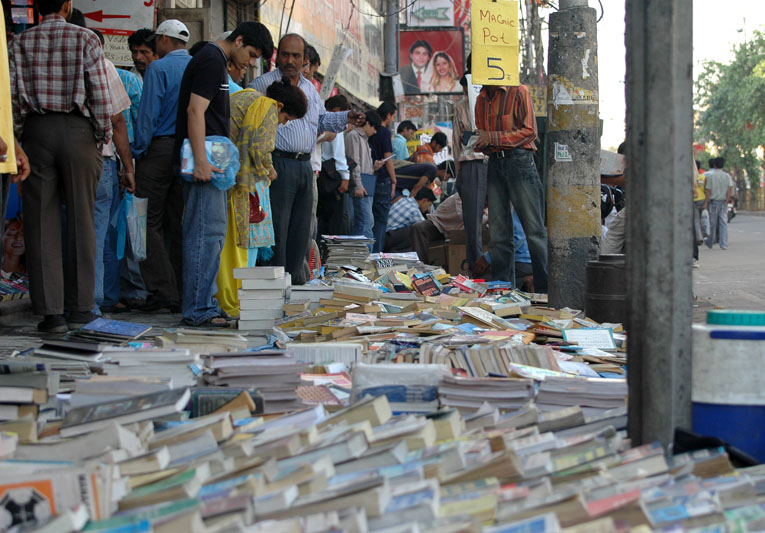
“What do you sell O ye merchants ?
Richly your wares are displayed.
Turbans of crimson and silver,
Tunics of purple brocade,
Mirrors with panels of amber,
Daggers with handles of jade.”
Although the above extract has been taken from Sarojini Naidu’s poem, In the Bazaars of Hyderabad, these lines embody a universal imagery applicable to all the bazaars in India. Before delving into the history and evolution of the bazaars in Delhi, we need to first trace how the concept of bazaars came into being. A bazaar or souk, is a permanently enclosed marketplace or street where goods and services are exchanged or sold. The term bazaar originates from the Persian word bāzār, however the term has now become universal. Although the lack of archaeological evidence has limited detailed studies of the evolution of bazaars, indications suggest that they initially developed outside city walls where they were often associated with servicing the needs of caravanserai.
When Mughal Emperor Shahjahan transferred his capital from Agra to Delhi and established the city of Shahjahanabad, he had the majestic Red Fort or Lal Qila, on the banks of the river Yamuna. Chandni Chowk was built in 1650 AD as an accompaniment to the fort. It was designed by Jahanara, the Emperor’s eldest daughter. A large chowk (square) with a central pool was built at some distance from the fort. Chandni Chowk or the moonlit square was dubbed as such because on a moonlit night, the complex and the pool lay shimmering. Another legend says that the Chowk was named after it’s silversmiths as the word Chandi (silver) and Chandni (moonlit) are often misconceived. Chandni Chowk is still one of the most important commercial hubs in Delhi, but the aesthetic charm of the place has passed into oblivion. Narrow by-lines swarming with people is how one would find this once majestic market.
Another bazaar belonging to the old city of Shahjahanabad is the Daryaganj book bazaar. According to Sohail Hashmi, it was Akbarabadi Begum, one of Shahjahan’s wives, who designed this market. The name, Daryaganj, signifies a market across a river, where Darya implies a river and Ganj refers to a site where trade is conducted. It was only in the 1960s, that Daryaganj became the centre for the sale of used, rare, pirated books. According to locals, Daryaganj started as a consumer goods market, set up adjacent to the walls between Subhash Park and Kasturba Gandhi Hospital. There were vinyl records and handcrafted record players, radios, used clothes and books which were sold. Based on a Delhi High Court order dated July 3, 2019 North Delhi Municipal Corporation mandated that the street market be removed, quoting traffic concerns. Relocated to the organised Mahila Haat, the Sunday book market is trying to work out if it has gained or lost.
Created For Pakistani Refugees in 1951, Khan Market transformed into a safe haven for refugees from Pakistan and other areas after the partition of 1947. The area was named after the freedom fighter Khan Abdul Jabbar Khan, the elder brother of Abdul Ghaffar Khan or Frontier Gandhi. Around 74 refugee families had moved to Khan Market in the 1950s but as of right now only 3 of them remain there. Khan Market might be a posh market for many, but it is also a nostalgic place for others. People, whose life had been uprooted by the partition found a home in the lanes of the marketplace. Connaught Place was designed by Robert Tor Russell and was named after the Duke of Connaught. It was made to serve the elite living in Delhi, especially in areas designed by the architect Edwin Lutyens, now known as the Lutyens Bungalow Zone (LBZ).The architecture of CP is inspired from the Royal Crescent in Bath with the only difference being that the latter is semi-circular and three-storied. It can be easily deduced that these markets were specially designed for a certain section of the society to cater to their needs. In fact, historian Swapna Liddle claims that Khan market is less inclusive than CP which is the hub of inclusiveness. This binary of inclusivity and exclusivity is highly entrenched in our society implying several class and caste hierarchies.

Sarojini Nagar Market is another bazaar which is highly popular and symbolizes inclusivity, and attracts a large number of locals and tourists belonging to diverse economic backgrounds and is located in the South Western region of Delhi. This market is famous for garment and fabrics, stylish outfits and other items retailed at unbeatable low prices. It was established during the 1950s as a local market place to cater to the daily requirements of the Sarojini Nagar Government Colony residents such as the Indian Central Government staff as well as the state Government staff who were allotted DDA flats in this colony during the early 1950s. Up till the late 1960s, this colony and its shopping complex was known as ‘Vinay Nagar’ and after the 1970s, this area was officially renamed as Sarojini Nagar in honour of Sarojini Naidu.
However, these eclectic markets which have been an integral part of Delhi for eons were severely affected financially during the pandemic and had to face the wrath of the subsequent lockdown which was put in place amid coronavirus scare on March 25 by the central government. All marketplaces were shut for over two months to curb the spread of the virus and break its chain. However, the COVID 19 guidelines and social distancing protocols made it difficult for the sellers and business owners to thrive and sustain their livelihoods. The Daryaganj book market which was standing on its last legs before the pandemic may become extinct even after the pandemic ends. Moreover, many shop owners in Khan market and CP have shifted their business online and are looking for new and different avenues to expand their income. Although 2021 has started on a good note with businesses improving, many shop owners are extremely apprehensive of the future and what it will entail.


